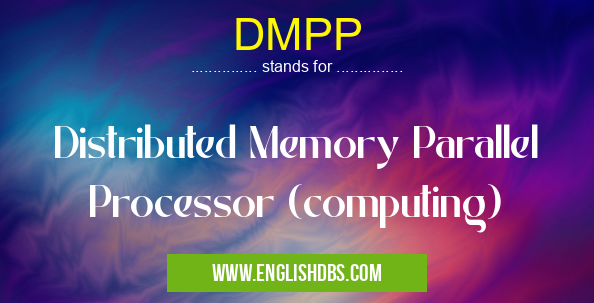What does DMPP mean in COMPUTING
Distributed Memory Parallel Processor (DMPP) is a computing architecture that employs multiple processors, each with its memory, connected over a communication network. This architecture enables parallel processing, where tasks are distributed across the processors, allowing for increased computational power and efficiency.

DMPP meaning in Computing in Computing
DMPP mostly used in an acronym Computing in Category Computing that means Distributed Memory Parallel Processor (computing)
Shorthand: DMPP,
Full Form: Distributed Memory Parallel Processor (computing)
For more information of "Distributed Memory Parallel Processor (computing)", see the section below.
Key Features
- Distributed Memory: Each processor has its dedicated memory, eliminating the need for shared memory.
- Message Passing: Processors communicate by exchanging messages through the network.
- Scalability: DMPP systems can be scaled up by adding more processors, providing increased performance.
- Fault Tolerance: Fault tolerance mechanisms can be implemented to handle processor or network failures.
Advantages
- High Performance: Parallel processing allows for faster execution of computationally demanding tasks.
- Scalability: The ability to add more processors enables linear performance scaling.
- Cost-Effectiveness: DMPP systems can be more cost-effective than shared memory systems for large-scale computations.
Applications
DMPP systems are used in various applications, including:
- Scientific Computing (e.g., simulations, data analysis)
- High-Performance Computing (e.g., weather forecasting, climate modeling)
- Data Analytics (e.g., machine learning, deep learning)
Essential Questions and Answers on Distributed Memory Parallel Processor (computing) in "COMPUTING»COMPUTING"
What is DMPP?
DMPP, or Distributed Memory Parallel Processor, is a type of parallel computer system where processors have their own local memory and communicate with each other over a network.
What are the advantages of using DMPP?
Advantages of using DMPP include increased processing power, improved performance, and the ability to handle large datasets.
How does DMPP differ from shared-memory parallel processors?
In DMPP, each processor has its own local memory, while in shared-memory parallel processors, all processors share a common memory space. This difference affects communication and data management strategies.
What are some applications where DMPP is used?
DMPP is used in various applications, such as scientific simulations, data analytics, and machine learning, where large-scale computations and data processing are required.
What are the challenges in using DMPP?
Challenges in using DMPP include managing communication between processors, optimizing data partitioning, and handling load balancing to ensure efficient utilization of resources.
What are the future trends in DMPP?
Future trends in DMPP include the development of high-speed interconnects for improved communication, the use of heterogeneous processors for increased efficiency, and the exploration of new programming models for simplified development.
Final Words: Distributed Memory Parallel Processors (DMPP) offer a powerful and scalable computing architecture for demanding computational tasks. By distributing memory and tasks across multiple processors, DMPP systems achieve high performance, scalability, and cost-effectiveness, making them suitable for a wide range of applications in scientific computing, high-performance computing, and data analytics.
